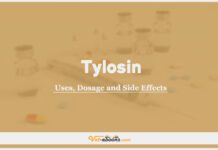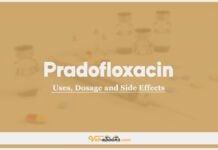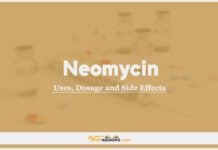Amikacin for Dogs, Cats, and Other Species: Dosage, Uses, and Side Effects Guide

Overview
Amikacin is one of Aminoglycosides which inhibits bacterial protein synthesis with a
concentration-dependent mechanism of killing, leading to a marked post-antibiotic effect, allowing prolonged dosing intervals (which may reduce toxicity).
Uses of Amikacin
- Dogs and Cats:
- Treatment of serious Gram-negative infections, including sepsis.
- Used topically for otitis externa (combined with EDTA-Tris).
- Administered locally for intra-articular infections or infections in the bladder.
- Horses:
- Treatment of septic arthritis via intra-articular injection or intravenous regional limb perfusion (IVRLP).
- Intrauterine infusion for endometritis, metritis, and pyometra.
- New World Camelids (e.g., llamas):
- Empirical therapy for susceptible infections.
- Birds and Reptiles:
- Management of Gram-negative infections resistant to other aminoglycosides.
Dosage of Amikacin in Different Animal Species
Amikacin Dose in Dogs, Cats and Different Animal Species:
| Species | Condition Treated with Amikacin | Dosage |
|---|---|---|
| Dogs | Susceptible infections and empirical therapy | 15–30 mg/kg IV, IM, SC once daily. For septic patients: 20–30 mg/kg IV once daily. Note: Adjust based on kidney function and serum concentrations. |
| Cats | Susceptible infections and empirical therapy | 10–15 mg/kg IV, IM, SC once daily. For septic patients: 20 mg/kg IV once daily. Note: Adjust based on kidney function and serum concentrations. |
| Horses | Uterine infections | 2 g in 200 mL sterile saline, infused into the uterus daily for 3 days. |
| Susceptible infections and empirical therapy | Adults: 10 mg/kg IV or IM once daily; Neonatal foals: 20–25 mg/kg IV or IM once daily. | |
| Septic joints (intra-articular) | 125–250 mg IA once daily. | |
| IV regional limb perfusion (IVRLP) | 1–2 g diluted with saline, infused via cephalic vein with a 10–30 min tourniquet. | |
| New World Camelids | Susceptible infections and empirical therapy | 18 mg/kg IV or IM once daily. |
| Birds | Susceptible infections | 15 mg/kg IM or SC every 12 hours. |
| Gram-negative infections (gentamicin-resistant) | 15–20 mg/kg IM once or twice daily. | |
| IV regional limb perfusion (IVRLP) in chickens | 5.3 mg/kg IV with flunixin, 15 min tourniquet time. | |
| Mycobacterial infections in psittacines | 15 mg/kg twice daily, route not specified. | |
| Reptiles | Gram-negative respiratory disease | 3.5 mg/kg IM, SC, or via lung catheter every 3–10 days. |
| Snakes (general) | 5 mg/kg IM loading dose, then 2.5 mg/kg IM every 72 hours. | |
| Turtles/Tortoises (bacterial shell disease) | 10 mg/kg IM daily for water turtles; every other day for land turtles. | |
| Ferrets | Susceptible infections (extra-label) | 8–16 mg/kg IM or IV once daily. |
| Rabbits/Small Mammals | Rabbits | 8–16 mg/kg SC, IM, or IV once daily; can be divided every 8–24 hours. Dilute IV dose in saline. |
| Guinea Pigs | 10–15 mg/kg SC, IM, or IV every 8–24 hours. | |
| Fish | Susceptible infections | 5 mg/kg IM loading dose, then 2.5 mg/kg every 72 hours for 5 treatments. |
Drug Dosage Calculator
You Should Give:
Side Effects of Amikacin
- Nephrotoxicity: May cause renal tubular necrosis, manifested by increased BUN/creatinine levels and reduced urine specific gravity.
- Ototoxicity: Irreversible hearing loss or vestibular effects. Cats are more prone to vestibular signs, such as nystagmus and ataxia.
- Neuromuscular blockade: May occur with anesthetics or magnesium sulfate.
- Injection site reactions: Pain, inflammation, and peripheral neuropathy.
Contraindications of Amikacin
- Renal dysfunction: Use with caution and adjust dosing intervals.
- Hearing impairment: Avoid if the tympanic membrane is not intact.
- Neuromuscular disorders: Avoid in patients with myasthenia gravis.
Important Notes
- Drug Interactions:
- Beta-lactams (penicillin, cephalosporins): Inactivate aminoglycosides when mixed.
- Diuretics (e.g., furosemide): Increase nephrotoxicity.
- Neuromuscular blockers: Potentiate neuromuscular blockade.
- NSAIDs: Increase nephrotoxicity risks.
- Monitoring:
- Monitor renal function with serum creatinine and urinalysis every 3–5 days.
- Therapeutic drug monitoring: Check peak and trough serum levels for toxicity.
- Observe for vestibular or auditory toxicity.
- Administration Considerations:
- Administer IV doses slowly over 30–60 minutes with concurrent fluid therapy.
- Avoid combining with incompatible solutions in the same syringe or IV line.
Tip
Do You Want To Increase Your Veterinary Knowledge and Practical Skills?
You Can Now Browse and Download +3000 Books For Veterinary Professionals & Students Online.
Download Veterinary Books




















